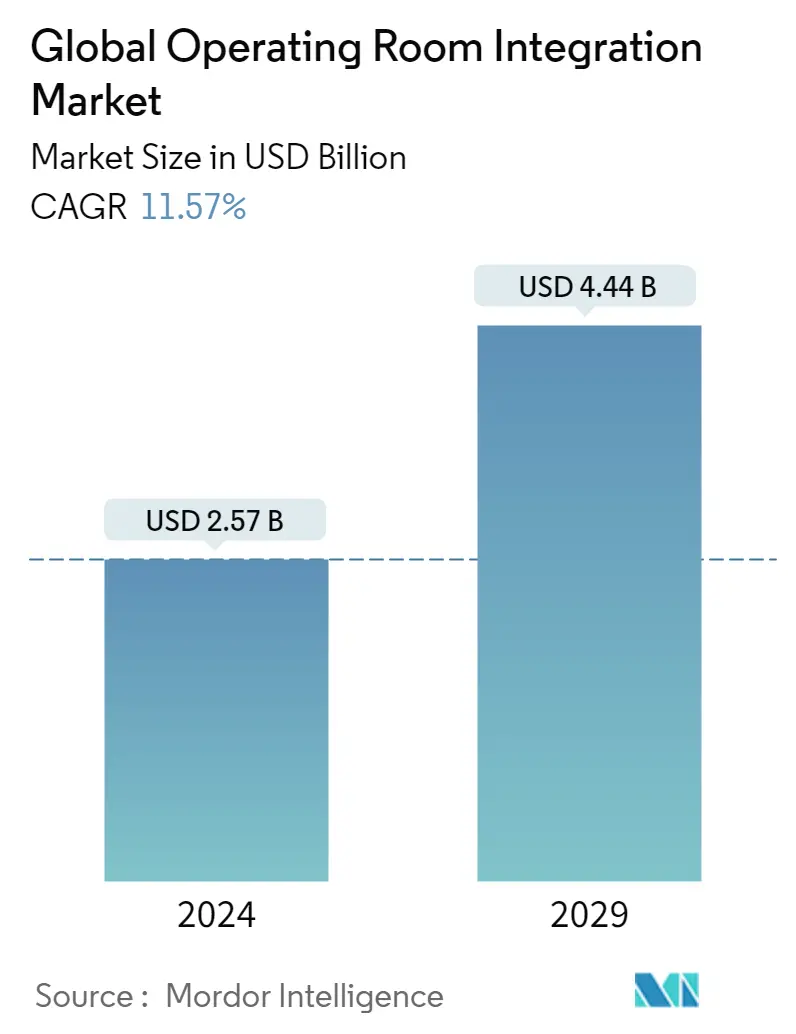Market Size of Global Operating Room Integration Industry

| Study Period | 2019 - 2029 |
| Market Size (2024) | USD 2.57 Billion |
| Market Size (2029) | USD 4.44 Billion |
| CAGR (2024 - 2029) | 11.57 % |
| Fastest Growing Market | Asia-Pacific |
| Largest Market | North America |
Major Players
*Disclaimer: Major Players sorted in no particular order |
Operating Room Integration Market Analysis
The Global Operating Room Integration Market size is estimated at USD 2.57 billion in 2024, and is expected to reach USD 4.44 billion by 2029, growing at a CAGR of 11.57% during the forecast period (2024-2029).
The COVID-19 caused considerable wait times for patients standing by for surgery. A study published in the British Journal of Surgery showed that COVID-19 led to 28 million postponed or canceled surgeries globally in 2020 with millions of surgeries pushed into 2021. Thus, with thousands of patients facing delays in surgeries the necessity to enhance scheduling efficiencies has become more important. Furthermore, the pandemic has pushed market players to operate in new ways, thus accelerating digitization. Operating rooms and surgical procedures changed in the following three ways in response to the pandemic-increased pre-surgical planning, video conferencing, and remote post-surgical patient engagement.
The factors such as a surge in patient procedures for minimally invasive surgeries are the major driving factors for the growth of the market. This is mainly due to the increasing awareness about the surgical interventions to treat conditions such as obesity has led medical device manufacturers to develop advanced operating room integration. Additionally, growth in the geriatric population resulting in the rising demand for surgeries which results in a cumulative increase in the number of operating procedures is also expected to drive the growth of the market. For instance, in 2020, the article titled 'The Incidence and Cumulative Risk of Major Surgery in Older Persons in the United States mentioned that nearly 9 major surgeries were performed annually for every 100 older persons, and more than 1 in 7 Medicare beneficiaries underwent a major surgery over 5 years, representing nearly 5 million unique older people.
Moreover, the rising burden of chronic disease across the globe is also one of the major factors increasing the demand for the operating room, as end-stage chronic diseases generally demand surgery. For instance, as per the American Health Association, in 2022, operating rooms resumed their activities and observed an upsurge in medical health treatments and surgeries, leading to only a 10% lower rate of surgery by the end of 2020 in comparison to 2019. Moreover, per the Organization for Economic Cooperation and Development (OECD), the number of cataract surgical procedures reported in 2020 in Turkey was 393,901. According to the same source, the number of hip replacement procedures in Italy in 2020 was 84,647, and cesarean section procedures were approximately 114,601. Thus, this growth in the number of surgical procedures will likely increase the demand for the operating room, thereby contributing to market growth.
Thus the above-mentioned factors are expected to drive the growth of the market during the forecast period.
Operating Room Integration Industry Segmentation
As per the scope of the report, integrated operating rooms are designed to lessen the complexity of the most intricate environments inside a hospital, a private clinic, or a medical institute. The operating room integration market is segmented by component (software and services), application (general surgery, orthopedic surgery, cardiovascular surgery, neurosurgery, and others), and geography (North America, Europe, Asia-Pacific, Middle-East and Africa, and South America). The market report also covers the estimated market sizes and trends of 17 countries across major regions globally. The report offers values (in USD million) for the above-mentioned segments
| By Component | |
| Software | |
| Services |
| By Application | |
| General Surgery | |
| Orthopedic Surgery | |
| Cardiovascular Surgery | |
| Neurosurgery | |
| Others |
| Geography | ||||||||
| ||||||||
| ||||||||
| ||||||||
| ||||||||
|
Global Operating Room Integration Market Size Summary
The operating room integration market is poised for significant growth, driven by the increasing demand for advanced surgical procedures and the rising prevalence of chronic diseases. The market is experiencing a transformation due to the surge in minimally invasive surgeries and the growing geriatric population, which necessitates more surgical interventions. The COVID-19 pandemic has further accelerated the need for enhanced scheduling efficiencies and digitization in operating rooms, as it led to a substantial number of postponed surgeries. This has prompted market players to innovate and adapt to new operational methodologies, such as increased pre-surgical planning and remote patient engagement. The market is characterized by a competitive landscape with major players like Brain Lab AG, Canon Inc., and Stryker Corporation leading the charge in developing advanced operating room integration solutions.
The United States is expected to dominate the global market, fueled by the high prevalence of chronic diseases and the adoption of advanced surgical treatment methodologies. The presence of favorable healthcare infrastructure and a strong focus on research and development further bolster the market's growth in the region. The cardiovascular surgery segment is anticipated to hold a significant share, driven by the rising incidence of cardiovascular diseases and the demand for improved surgical procedures. As the market continues to evolve, companies are increasingly leveraging artificial intelligence and other advanced technologies to optimize surgical workflows and enhance procedural efficiency. This dynamic environment is expected to sustain the market's growth trajectory over the forecast period.
Global Operating Room Integration Market Size - Table of Contents
-
1. MARKET DYNAMICS
-
1.1 Market Overview
-
1.2 Market Drivers
-
1.2.1 Rise in number of surgical procedures
-
1.2.2 Surge in patient preference for minimally invasive surgeries and Patient Safety concerns in operating room
-
-
1.3 Market Restraints
-
1.3.1 High cost and maintenance of the operating room integration
-
-
1.4 Porter's Five Force Analysis
-
1.4.1 Threat of New Entrants
-
1.4.2 Bargaining Power of Buyers/Consumers
-
1.4.3 Bargaining Power of Suppliers
-
1.4.4 Threat of Substitute Products
-
1.4.5 Intensity of Competitive Rivalry
-
-
-
2. MARKET SEGMENTATION (Market Size by Value - USD million)
-
2.1 By Component
-
2.1.1 Software
-
2.1.2 Services
-
-
2.2 By Application
-
2.2.1 General Surgery
-
2.2.2 Orthopedic Surgery
-
2.2.3 Cardiovascular Surgery
-
2.2.4 Neurosurgery
-
2.2.5 Others
-
-
2.3 Geography
-
2.3.1 North America
-
2.3.1.1 United States
-
2.3.1.2 Canada
-
2.3.1.3 Mexico
-
-
2.3.2 Europe
-
2.3.2.1 Germany
-
2.3.2.2 United Kingdom
-
2.3.2.3 France
-
2.3.2.4 Italy
-
2.3.2.5 Spain
-
2.3.2.6 Rest of Europe
-
-
2.3.3 Asia-Pacific
-
2.3.3.1 China
-
2.3.3.2 Japan
-
2.3.3.3 India
-
2.3.3.4 Australia
-
2.3.3.5 South Korea
-
2.3.3.6 Rest of Asia-Pacific
-
-
2.3.4 Middle-East and Africa
-
2.3.4.1 GCC
-
2.3.4.2 South Africa
-
2.3.4.3 Rest of Middle-East and Africa
-
-
2.3.5 South America
-
2.3.5.1 Brazil
-
2.3.5.2 Argentina
-
2.3.5.3 Rest of South America
-
-
-
Global Operating Room Integration Market Size FAQs
How big is the Global Operating Room Integration Market?
The Global Operating Room Integration Market size is expected to reach USD 2.57 billion in 2024 and grow at a CAGR of 11.57% to reach USD 4.44 billion by 2029.
What is the current Global Operating Room Integration Market size?
In 2024, the Global Operating Room Integration Market size is expected to reach USD 2.57 billion.

